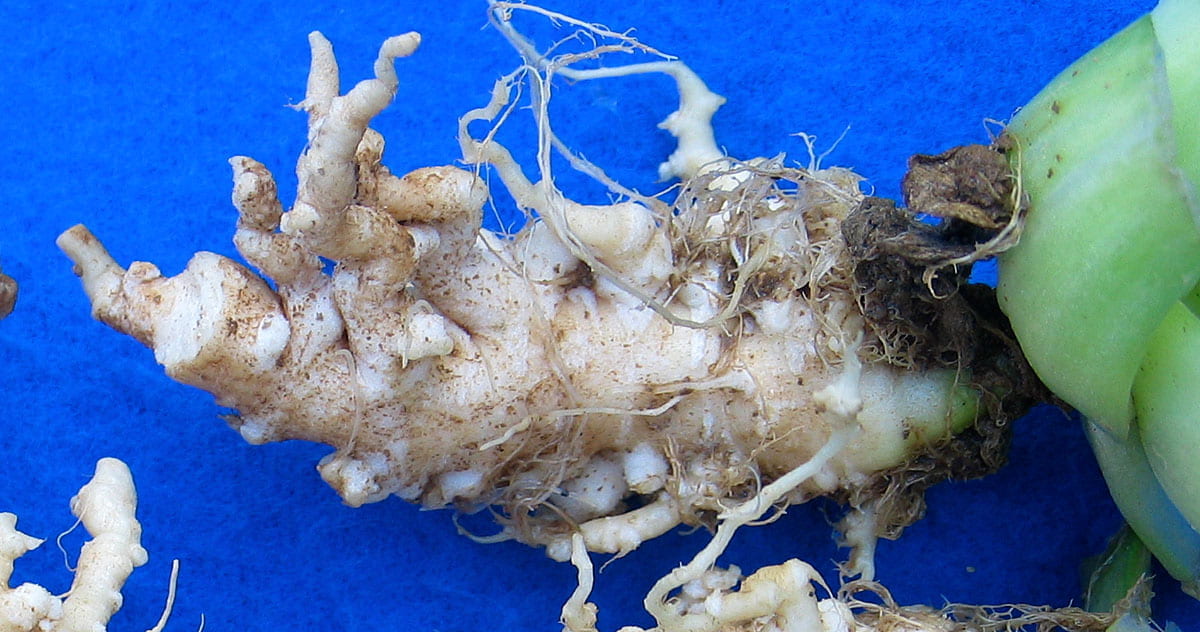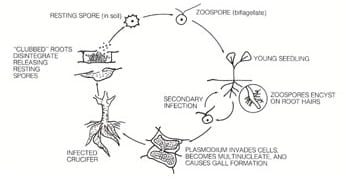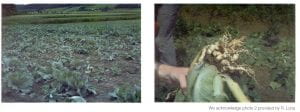Clubroot remains one of the important diseases affecting members of the mustard, or Cruciferae, family. The disease occurs worldwide and affects such important crops as cabbage, cauliflower, Brussels sprouts, broccoli, and Chinese cabbage. Every effort should be made to keep contaminated crucifer transplants from entering a farming operation because the pathogen survives for many years even in the absence of host crops. Clubroot can cause drastic yield reduction and occasionally total losses in crucifers.
Cause
Clubroot of cabbage and related crucifers is caused by the soilborne pathogen Plasmodiophora brassicae which belongs to the plasmodiophorids. It was considered to be a fungus before it was reclassified in the Plasmodiophoromycota. This relatively simple organism forms no mycelia (numerous threadlike branches) and is an obligate parasite, meaning that it can develop and multiply only in living host cells. Its vegetative phase consists of a multinucleate mass of protoplasm lacking a cell wall (plasmodium or slime mold). Although the organism primarily attacks members of the Cruciferae, the intensity of disease caused on different crops (see “Host Range”) varies. The organism also exists as many specialized forms or races, the variation in plant resistance and ability to survive in different areas being explained thereby.
Symptoms
Clubroot may develop extensively on plant roots before the first sign (an abnormal wilting and yellowing of leaves, especially on warm days) is noticed aboveground (image below, left). If the soil is moist, these symptoms may not become apparent until water stress occurs. When infection occurs at an early stage of growth, young plants are stunted and may die, whereas plants infected in a later stage fail to make marketable heads or growth. When diseased plants are pulled from the soil, the roots are usually swollen and distorted (image below, right). The name clubroot is derived from these symptoms. Root malformation may vary in size from very small swellings on the tap and lateral roots to large club-shaped roots, depending on when the plants became infected. In addition to reducing the plant’s ability to take up water, the clubbed tissue fails to develop a protective outer layer and, thus, is susceptible to invasion by soft rotting bacteria.

Disease Cycle

The disease cycle for clubroot is illustrated in the diagram. P. brassicae is capable of surviving in the soil for 7-10 years or longer as resting spores. Its resting spores can be spread from field to field by infested soil, contaminated water supplies, infected transplants, infested soil on farm machinery, and even by roving animals such as cattle. When soil conditions dictate, the resting spores of the pathogen germinate to produce zoospores, which are able to “swim” by means of flagella to infect susceptible plant root hairs. Germination of resting spores requires moist, acid soil and can occur over a wide temperature range of 54°-81 ° F (12°-27° C). Disease development is favored by high soil moisture and soil temperatures between 64°-77° F (18°-25° C). Although clubroot has been found in soils exhibiting a wide pH range from 4.5-8.1, the disease is primarily associated with acid soils. Within the infected plant roots, the organism develops rapidly, causing an increase in the number and size of cells, which results in “clubbing.” During the development of the organism in the plant, new zoospores are produced; these are capable of infecting the same plant or adjacent plants and, thus, repeating the cycle. Eventually, resting spores are formed within the diseased plant tissue, and these are released into the soil when the plant roots disintegrate.
Host Range
The disease is restricted mainly to members of the mustard family, both cultivated and weeds, and to a few other plants. Because of the existence of races in this organism, plants can respond to attack on different levels, but in the Northeast they can be grouped as follows:
- Most susceptible: cabbage, Chinese cabbage, Brussels sprouts, some turnips, wormseed mustard, and some species of candytuft
- Medium susceptible: kohlrabi, kale, cauliflower, collards,broccoli, rutabaga, seakale, some turnips and radishes, and some species of candytuft
- Mildly susceptible: rape (canola), black mustard, some turnip and radish varieties, and tumble mustard
- Very resistant or occasionally immune: wintercress; or yellow rocket, horseradish, shepherd’s purse, wallflower, dames violet, peppergrass, garden cress, stock, and some radishes
Although clubbing symptoms are unique to members of the Cruciferae, P. brassicae is capable of infecting the root hairs of the following noncruciferous hosts in the indicated plant families: Gramineae, redtop (Agrostis alba var. stoloniferae), orchardgrass (Dactylis glomerata), and ryegrass (Lolium perenne); Rosaceae, strawberry (Fragaria spp.); Papaveraceae, corn poppy (Papaver rhoeas); Polygonaceae, dock (Rumex spp.); Resedaceae, mignonette (Reseda odorata); Leguminosae, red clover (Trifolium pratense).
Control Measures
Most control measures for clubroot are aimed at preventing the introduction of the pathogen into a field. Clubroot is not seedborne, but the chief means of spread is by the use of contaminated transplants.
- When using transplants produced elsewhere, use plants that are certified by the official state certifying agency. Even if a trace of clubroot is present on a few plants, reject the entire lot. Many other seedlings may be infected and are simply not expressing symptoms.
- Carefully choose sites for crucifer seedbeds that do not have a history of clubroot. Do not contaminate the area by using irrigation water from sources that may be contaminated. If there is any doubt about soil contamination, seedbed areas may be fumigated with Vapam (a restricted-use pesticide). Production fields also can be fumigated. Follow manufacturer’s directions.
- If a field is known to be infested, the soil pH should be adjusted to pH 6.8 with ground limestone (CaC03). In addition to the limestone, broadcast and incorporate at least 1,500 pounds per acre of hydrated lime (calcium hydroxide Ca(OH)2) before planting. It is essential that hydrated lime be added each year unless the soil pH exceeds 7.5. Regardless of how finely ground, limestone alone will not control clubroot. Soil test recommendations from Cornell will include liming requirements for crucifers as part of the report.Although the way in which lime reduces infection by P. brassicae is not understood, it is thought that control is enhanced when the calcium concentration in the soil is very high. Because the use of nitrogen fertilizers will reduce soil pH (nullifying the beneficial effects of liming) and because some crops in rotation with crucifers are sensitive to heavy lime applications, it is important to check thesoil pH regularly.
- There are fungicides labeled for use at planting. For labeled fungicides see current Cornell Integrated Crop and Pest Management Guidelines for Commercial Vegetable Production.
- Always thoroughly clean farm equipment after working in a field suspected of having the clubroot pathogen.
- A rotation of at least 7 years out of susceptible crucifers may be effective. For this rotation to be effective, make sure susceptible weeds and plants mentioned under “Host Range” are excluded.
- Resistance: The first resistant cabbage variety Badger Shipper from Wisconsin was developed by a chance cross of cabbage with kale. Additional cabbage breeding lines that are promising have been released from Oregon. Because of the existence of different clubroot races in many localities, varieties claiming resistance need to be evaluated under New York conditions. Current information is in Resistant Varieties tables
More information/prepared by:
Originally created for the Vegetable MD Online website by T.A. Zitter. Updated May 2021 by:
Margaret Tuttle McGrath
Associate Professor
Long Island Horticultural Research and Extension Center (LIHREC)
Plant Pathology and Plant-Microbe Biology Section
School of Integrative Plant Science
College of Agriculture and Life Sciences
Cornell University
mtm3@cornell.edu



